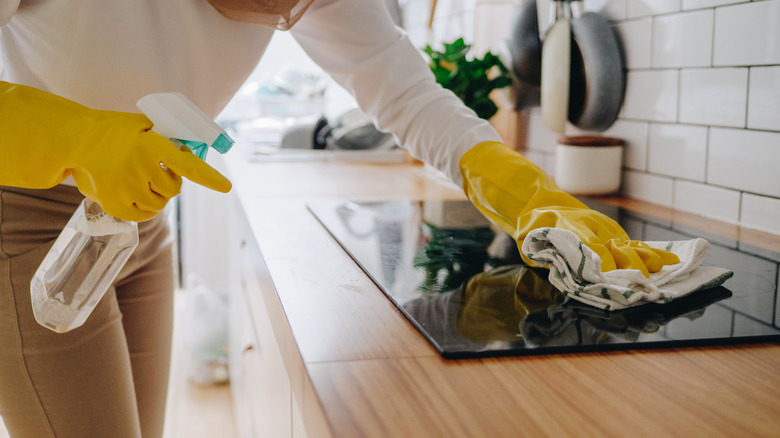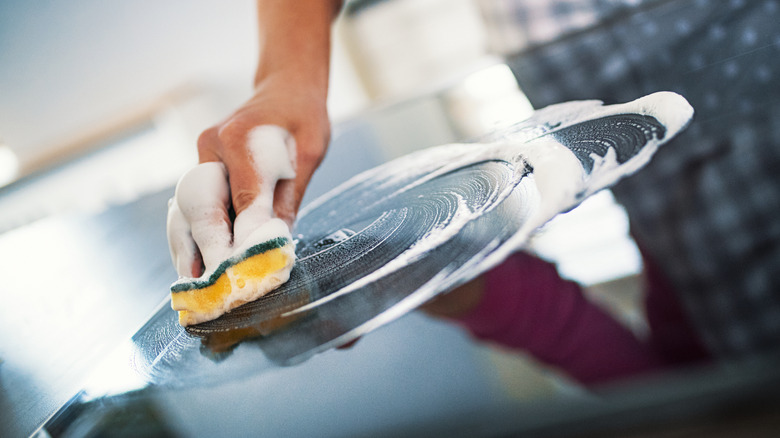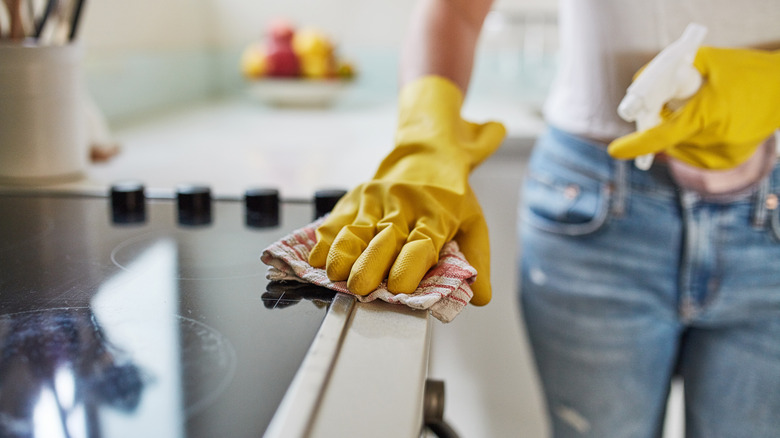The Medicine Cabinet Staple Pinterest Recommends Using To Clean Glass Stove Tops
Choosing a glass cooktop for your kitchen is a great idea as it can be a much simpler surface to clean than intricate electric stove tops with coils or the cast iron grates that accompany gas. A glass top can be easily wiped down after use, but you should make a deeper clean part of your routine. Regularly cleaning a glass stove top is important to discourage pests and bacteria and to ensure that your appliance continues to work well. Moreover, you can prevent damage from stubborn stains or an accidental fire that could spawn from any neglected spills or splatters.
While there are plenty of commercial cleaners for glass stove tops, you can easily make an all-natural DIY cleaner using hydrogen peroxide and a few other common household ingredients. According to Grapes and Splendor's article featured on Pinterest, Hydrogen peroxide is a super effective tool for disinfecting and cleaning your glass cooktop because it is a great degreaser. Hydrogen peroxide can efficiently cut through stubborn stains and grease associated with stove tops without having to rely on commercial cleaners, which are often full of toxic chemicals that can be unsafe for inhalation or skin contact. Hydrogen peroxide, on the other hand, is an eco-friendly substance that ultimately breaks down to just oxygen and water which is much gentler on the cooktop and your body. Additionally, hydrogen peroxide is an affordable product that you probably already have at home and can now serve a dual purpose for cleaning cuts and disinfecting your stove.
How to clean glass stove tops with hydrogen peroxide
If you're ready to have your glass stove top sparkle, all you'll need to proceed is a bottle of hydrogen peroxide, some baking soda, and a little dish soap. To begin, it's important to wait for your stove to cool so that you can avoid any accidental burns. Then Grapes and Splendor's Pinterest article recommends mixing 2 tablespoons of baking soda, ¼ cup of dish soap, and 3 tablespoons of hydrogen peroxide in a small bowl. Once combined, you can pour this solution over the top of your glass stove and use a sponge to spread it across the surface, paying particular attention to any areas with caked-on grease or food debris. Grapes and Splendor recommends allowing the mixture to sit for about 20 minutes to begin to break down any grime, grease, or debris that has caked onto your stovetop.
Once the solution has sat for a few minutes, use your wet sponge or cloth to scrub any debris from the top of the surface. Focus your attention on particularly dirty areas or places with stubborn stains. Next, use a clean, damp cloth or sponge to wipe away the cleaning mixture from the surface of the stove. You may need to rinse your cleaning tool a few times to completely remove any residue. Finally, use a clean, dry cloth to wipe away any moisture.
Cautions for using hydrogen peroxide
While hydrogen peroxide can be a fantastic and powerful cleaning tool that allows you to skip the harsh chemicals found in typical commercial cleaners, it is a solution that should be used properly and with caution for your own protection. When using any cleaning solution, including hydrogen peroxide, it's important to wear gloves to protect your skin from any irritation that can occur as a result of handling this cleaner. On that note, it's always a good idea to use hydrogen peroxide in a well-ventilated area, too, as the fumes can be unpleasant to breathe and bother anyone with respiratory conditions.
Furthermore, before proceeding to clean your glass cooktop with this DIY solution, it's a good idea to consult your manufacturer's instructions to be sure that the specific cooktop you have is compatible with hydrogen peroxide, dish soap, and baking soda. If it offers specific cleaning instructions, it would be wise to follow them as it will help to prolong the life of your stove and prevent any accidental damage to the surface. If you are unsure or have misplaced the instructions, you can test the solution in an inconspicuous area before proceeding with the entire surface.
Finally, never mix cleaning solutions together. If you use hydrogen peroxide, follow the above instructions exactly, and do not add any other cleaners, particularly bleach or vinegar. Combining hydrogen peroxide with bleach can potentially be explosive. Combining hydrogen peroxide with vinegar will create peracetic acid, which is harmful to the skin, eyes, throat, nose, and lungs.



